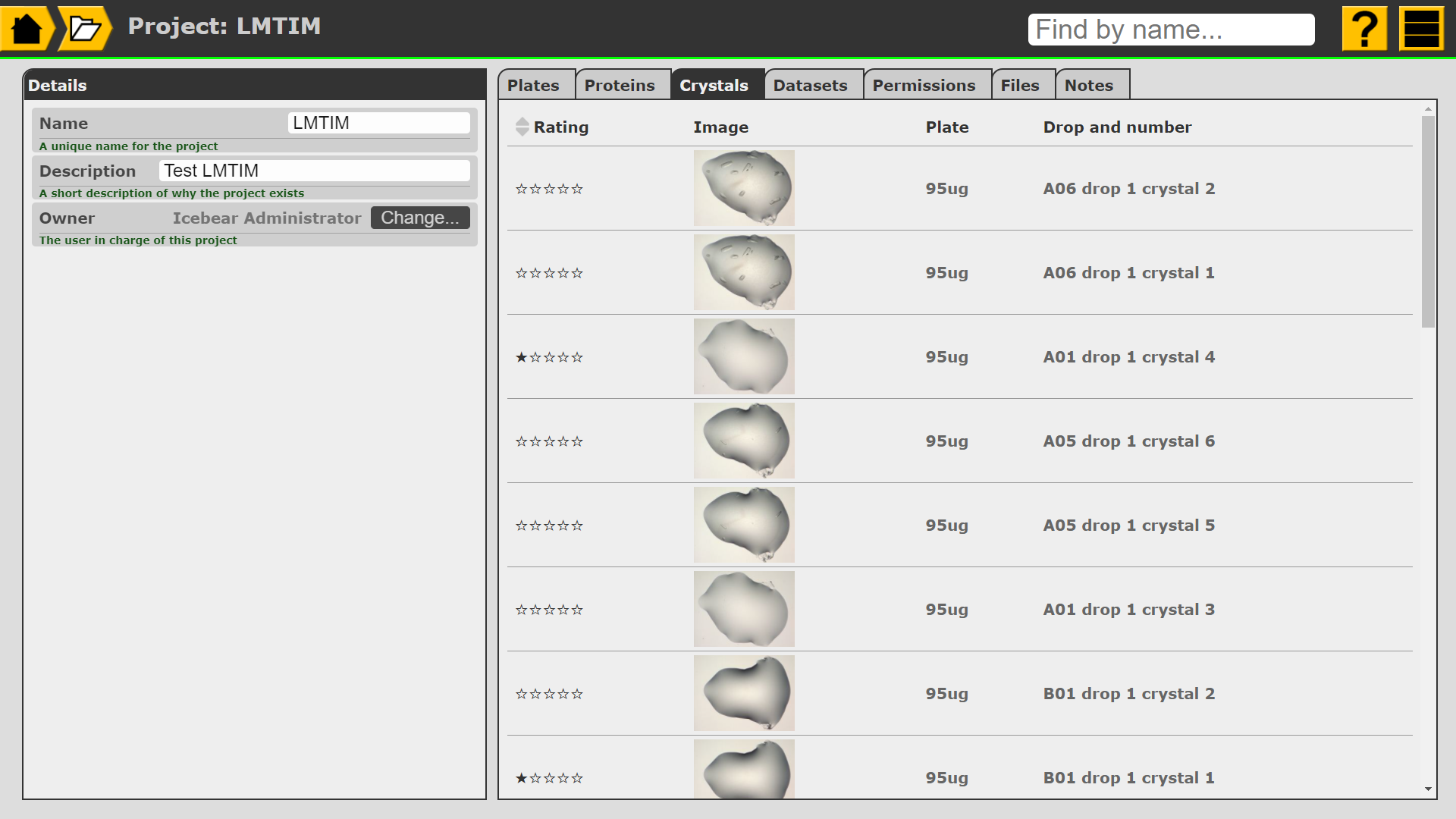
Everything in IceBear is put into a project. The access rights on the project determine who can see it - and everything in it.
Usually, you would want to have one project per protein. Your plates belong in the project for their protein.
There are two projects that have a special purpose: Shared and Default.
This project holds items that are likely to be common to all people. For example, equipment such as imagers would be in the Shared project. Plate types, standard screens, etc., are also likely to belong in the Shared project.
By default, everyone can see items in the Shared project but only people in the Technicians usergroup can modify them.
IceBear imports plates from the imaging system. It knows who owns the plate, but does not know what is in it. Therefore, it puts the plate into "Default project". Nobody can see the default project, but the plate owner can see the plate. They should set its protein correctly, to move it into the correct project. From then on, the project's permissions apply to the plate.
A project in IceBear looks like this:

On the left there is some basic information about the project. If you are an administrator or if you own the project, you will be able to edit this. Note that, if you own the project, changing the owner might leave you unable to see the project.
This lists all plates in this project, along with their owner. If any images in a plate have been scored, the best score for the plate is also shown here.
Click the plate barcode to go to the plate.
This is where you tell IceBear about the protein you are working with. Only the project owner can make changes in this tab.
You put your plates into the correct project by setting their protein, so it's important to put the protein information into your project.

You can create several proteins in one project, but you most likely want only one protein per project.
A protein has a name and a description, as well as a "protein acronym" which will be used to identify it in safety and shipping data at the synchrotron.
Proteins have one or more constructs, each of which can have multiple sequences (that is, complexes are supported). DNA or protein sequences can be supplied.

The Crystals tab lists all associated crystals. For each crystal, the image, plate, and well, drop and crystal number are shown.
There is also a star rating beside each crystal; you can change this in the crystal's view page or in the drop viewer. The star rating is entirely subjective, so it's up to you what they mean. You can sort the list to bring the best-rated crystals to the top.
Click the image to open it in the Drop Viewer. Click the plate name to go to the plate. Click the well and drop details to go to the crystal page.

The Datasets tab lists all associated datasets. For each dataset, its star rating, location and description are shown, along with the associated crystal and (if set) the PDB code. If the data location is a URL or DOI, clicking it will take you to the dataset itself. Clicking the PDB code or the crystal name will take you to the relevant IceBear page.
Datasets are managed on their respective crystal page. Click on the crystal name to go there.
Click the View... button to open the dataset. You can add notes if you wish.
If you have permission, you can change the star rating for the dataset. Star ratings are purely subjective, so it's up to you to decide what they mean.

This tab shows you which usergroups have permission to see and change items in the project (but not the project itself - only the owner and the administrators can do that). You may not have permission to see this tab.

The permissions for each group are shown. Administrators always have full permissions on any project.
In this example, the "Everyone" group has no permissions at all - most users cannot even see the project. Those in "Bob's Group" can read, update and create things in this project. A third group can read but not change anything.
Project owners, and administrators, can change some of these permissions. If the tick or cross looks like a button, just click it to turn the permission on or off.
Here you can see attached files, and attach new files if you have permission.
Any attached files are listed along with a description and the file size. Click the filename to open the file in a new tab.
If you have permission to add files, simply select the file, give a short description, and click the Add file button.
Here you can read any notes that have been made, and make new ones if you have permission.
All notes are labelled with the date and time when they were added, as well as with the name of the author. You don't need to write these into your note.
Only certain people have permission to create projects.
From the main menu, under Projects, click Add a project... From the list of projects, click the Create new... link at the top of the page.
Enter a name and a short description for the project, and click Create. You will be taken to the new project, where you can set up its permissions, etc. You can also change the owner, but - depending on your permissions and the project permissions - you may lose access to the project as soon as you do so. Set everything else up and change the project owner last.